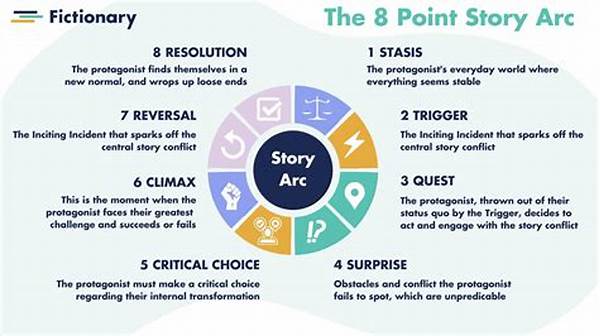In the world of storytelling, the traditional three-act structure has long been a staple, guiding writers and creators through beginning, middle, and end. However, the allure of breaking away from convention has inspired a wave of unconventional story arc creation, challenging norms and captivating audiences in new ways. Embracing this innovative approach, storytellers are devising narratives that defy expectations and push the boundaries of traditional storytelling.
The Bold Journey of Unconventional Story Arcs
Unconventional story arc creation begins with a willingness to explore the unknown. Rather than relying on traditional plot points, creators embark on a bold journey of narrative discovery. This method often involves nonlinear timelines, fragmented storytelling, or even blending multiple genres, offering a fresh outlook on familiar themes. For instance, a story might open with a resolution, creating intrigue by gradually revealing the preceding events. This approach keeps audiences guessing, forcing them to actively engage with the narrative and piece together the puzzle as they move along.
The charm of unconventional story arc creation lies in its unpredictability. It invites audiences to view stories through a new lens, often presenting them with a tapestry of perspectives that traditional arcs may overlook. Characters may evolve in unexpected directions, with their transformations revealed through subtle clues rather than a straightforward journey. As a result, viewers find themselves immersed in a dynamic storytelling experience, where each layer unfolds like a new chapter in a book, rich with complexity and depth. This challenge to traditional storytelling doesn’t discard the rules; rather, it reimagines them, producing narratives that resonate on a deeper, more intuitive level.
Techniques in Unconventional Story Arc Creation
1. Nonlinear Timelines: By shuffling the sequence of events, writers create intrigue and suspense, encouraging active audience engagement.
2. Multiple Storylines: Juxtaposing different narratives adds layers, allowing audiences to see varied perspectives before converging at key moments.
3. Unpredictable Endings: Surprise resolutions defy traditional expectations and leave lasting impressions.
4. Character-Driven Arcs: Focus on character evolution instead of plot progression, driving stories from the inside out.
5. Genre Blending: Combining elements from various genres challenges norms and keeps storytelling dynamic.
Embracing Unorthodox Narratives
Diving into the realm of unconventional story arc creation requires an embrace of unorthodox narratives. Writers and creators must dismiss the comfort of the predefined and instead harness creativity to imagine narratives that defy linear progression. This experimentation with structure allows the story to unfold organically, often taking on a life of its own. Decisions might be made on instinct rather than a strict adherence to conventional frameworks, resulting in narratives as unpredictable as they are engaging.
This creative freedom is not without its challenges. Unconventional story arcs demand a delicate balance between novelty and coherence. While conventional arcs provide a familiar path, the unconventional approach requires meticulous crafting to ensure the narrative remains compelling and cohesive. Audiences must be guided carefully through the emerging story, with threads woven strategically to maintain engagement throughout. This conscious blending of innovation with thoughtful storytelling ensures that the narrative, though unpredictable, feels meaningful and authentic.
Crafting Narratives Through Natural Sounding Language
A vital component of unconventional story arc creation is crafting narratives that employ a natural-sounding language. This style prioritizes genuine dialogue and organic scene-setting that makes the story feel real and relatable. Utilizing a natural tone allows audiences to connect with characters on an emotional level, fostering empathy and understanding.
1. Authentic Dialogue: Characters speak as they would in real life, avoiding clichés and overly formal language, which fosters genuine connections.
2. Descriptive Scenes: Natural descriptions paint vivid images, immersing audiences in the story world and engaging their senses.
3. Emotional Resonance: With natural language, emotions are conveyed subtly and authentically, resonating deeply with readers.
4. Relatability: Stories resonate more when audiences see reflections of their own speech patterns and experiences.
5. Simplicity and Clarity: Avoiding complex jargon ensures accessibility, making narratives enjoyable for a wide audience.
6. Show, Don’t Tell: Natural language emphasizes showing experiences rather than telling, creating immersive storytelling.
7. Intricate Character Development: With a focus on genuine interaction, characters develop through lived experiences reflected in their speech.
8. Narrative Flow: A natural-sounding language ensures smooth narrative progression that feels effortless and engaging.
9. Nuanced Reactions: Characters’ genuine responses deepen the realism and intricate nature of the narrative.
10. Cultural Authenticity: Utilizing natural language that reflects cultural nuances adds depth and realism.
Challenges in Unconventional Story Arc Creation
Unconventional story arc creation, while rewarding, presents challenges that require careful navigation. Adopting a non-traditional approach means creators must walk the line between innovation and coherence. Stories need an internal logic that feels plausible, even as they explore groundbreaking narratives. Ensuring audience engagement is key, as too much deviation can result in confusion rather than intrigue.
To achieve success, creators must ground their stories in relatable elements, such as characters’ genuine emotions and motivations. This balance provides an anchor that allows for an exploration of unique narratives without losing audience connection. Experimentation with structure requires an understanding of story dynamics and a willingness to adapt as the narrative unfolds. This fluidity transforms challenges into opportunities for innovation, allowing new and unexpected storytelling pathways.
Conclusion: The Future of Storytelling
Unconventional story arc creation signifies a bold evolution in the journey of storytelling. By challenging traditional norms, creators are unlocking new narratives that captivate audiences with their unpredictability and depth. The fusion of natural-sounding language and innovative structures results in stories that resonate on a profound level, creating genuine emotional engagement.
The ever-evolving landscape of storytelling is shaped by those willing to push boundaries and explore new possibilities. As these unconventional narratives continue to flourish, they redefine what storytelling can achieve, inspiring others to venture into the unknown and create compelling tales that linger in the minds of audiences worldwide. This willingness to embrace change ensures that storytelling remains a vital form of human expression, ever ripe with potential for transformation and discovery.
